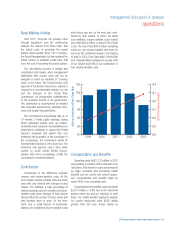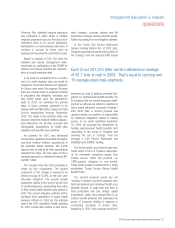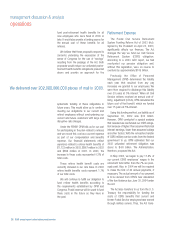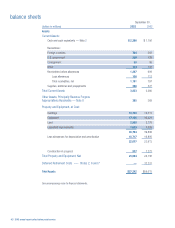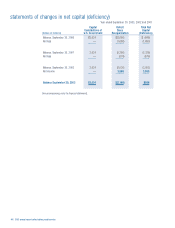US Postal Service 2003 Annual Report Download - page 36
Download and view the complete annual report
Please find page 36 of the 2003 US Postal Service annual report below. You can navigate through the pages in the report by either clicking on the pages listed below, or by using the keyword search tool below to find specific information within the annual report.
34 | 2003 annual report united states postal service
management discussion & analysis
capital
Future
Our capital plan for the future calls for cost
management by developing and deploying
new automation and mechanization equip-
ment that will increase our operating
efficiency. We will continue to concentrate on
maintaining such infrastructure as facilities,
vehicles and systems, as well as return on
investment (ROI) projects. Under this plan, we
will make investments in programs that
reduce work hours in our distribution,
processing and delivery operations. These
investments include the Optical Character
Reader Enhancement Program, Postal
Automated Redirection System (PARS) for
Letters – Phase 2 and PARS for Flats. The
Optical Character Reader Enhancements for
Letter Automation Program replaces
outmoded Multi-line Optical Character
Readers and results in a significant reduction
in space requirements for the equipment,
improved productivity and less maintenance.
PARS for Letters will automate the processing
of Undeliverable-As-Addressed mail and
greatly reduce the labor and time needed to
process this mail.
Our facilities program will continue to
address life, health, safety and security
issues. We will use existing space whenever
possible, invest in new construction only
when necessary and maintain our customer
service facility infrastructure to support the
growth of the delivery network.
The Emergency Preparedness Plan (EPP)
includes projects that address biohazard
detection and ventilation filtration systems to
provide a level of protection for our employees
and customers from potential contamination.
The Board of Governors has approved the
Biohazard Detection System and the
Ventilation Filtration System projects which we
will deploy during 2004 and beyond. A portion
of these investments has been funded under
the Homeland Security authorization in the
2002 Department of Defense Appropriations
Act. The remaining capital funding for these
and any other EPP-related projects will be allo-
cated from the 2004 capital plan as
necessary, pending any new appropriations.
(See Note 11 of the Notes to the Financial
Statements for additional information.)
0.0%
10.0%
20.0%
30.0%
40.0%
50.0%
60.0%
70.0%
80.0%
90.0%
100.0%
1999 2000 2001 2002 2003
75.6%
37.1%
42.8%
86.1%
501.6%
Capex Ratio



